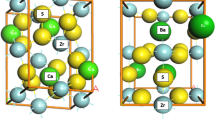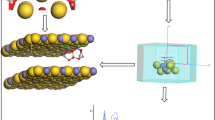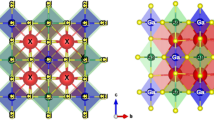Abstract
Since the experimental works published by Ugarte in 1993, nested almost perfect graphitic spheres have been generated in the condensed phase by irradiation with high-energy electrons of graphitic particles. The quasi-spherical shapes of these molecular systems were more marked than those obtained by Ijima by applying the arc-discharge method to amorphous carbon films. Although Ugarte was able to describe the influence of parameters such as temperature and dose of electronic radiation on the transformation of these structures, theoretically it has not been possible to explain the causes of the triggering of the above-mentioned process because of the complexity of these systems. Using a computational method based on density functional theory with tight-binding approximation (DFTB), the geometries of fullerenes of order \(n\le 6\) (2160 atoms) and carbon nano-onions (CNOs) of up to five layers were optimized, and the different energetic and geometric parameters of fullerenes and polyhedral CNOs were calculated. By introducing in the structure of these nanomaterials the point defects that are commonly produced during their irradiation (monovacancies, divacancies, and Stone–Wales), the possible structural deformations caused in these arrangements, as well as the formation energies were analyzed. The results obtained allow us to verify that \(\text {p}-\text {p}\) divacancies can modify the outermost nano-onion layers with an effect similar to that described experimentally by Ugarte.
Graphical Abstract









Similar content being viewed by others
Data Availability Statement
“This manuscript has no associated data or the data will not be deposited. [Authors’ comment: All data generated or analyzed during this study are included in this published article (and its supplementary information files).].
Notes
(A regular enneagon (or nonagon) is that regular polygon of nine sides (and nine vertices) that has all its sides of the same length and all its internal angles equal.)
References
J.L. Delgado, M.A. Herranz, N.J. Martín, Mater. Chem. 18, 1417 (2008). https://doi.org/10.1039/b717218d
A. Palkar, F. Melin, C.M. Cardona et al., Chem. Asian J. 2, 625 (2007). https://doi.org/10.1002/asia.200600426
J.M. Castagnino, Acta Bioquímica Clínica Latinoamericana 41, 189 (2007)
R.G. Amorim, A. Fazzio, A. Antonelli et al., Nano Lett. 7, 2459 (2007). https://doi.org/10.1021/nl071217v
C.P. Ewels, M.I. Heggie, P.R. Briddon, Chem. Phys. Lett. 351, 178 (2002). https://doi.org/10.1016/S0009-2614(01)01371-9
F. Banhart, Phys. Solid State 44, 399 (2002). https://doi.org/10.1134/1.1462655
F. Banhart, Phys. Eng. Sci. 362, 2205 (2004). https://doi.org/10.1098/rsta.2004.1436
F. Banhart, J. Kotakoski, A.V. Krasheninnikov, ACS Nano 5, 26 (2011). https://doi.org/10.1021/nn102598m
T. Xu, L. Sun. Defects in advanced electronic materials and novel low dimensional structures. 137 (2018). https://doi.org/10.1016/B978-0-08-102053-1.00005-3
F. Banhart, Rep. Prog. Phys. 62, 1181 (1999). https://doi.org/10.1088/0034-4885/62/8/201
D. Ugarte, Nature 359, 707 (1992). https://doi.org/10.1038/359707a0
D. Ugarte, Chem. Phys. Lett. 207, 473 (1993). https://doi.org/10.1016/0009-2614(93)89032-D
D. Ugarte, Carbon 33, 989 (1995). https://doi.org/10.1016/0008-6223(95)00027-B
R.E. Sosa-Ricardo, D. Codorniu-Pujals, M. Márquez-Mijares, Eur. Phys. J. D 72, 1 (2018). https://doi.org/10.1140/epjd/e2018-90101-4
B. Hourahine, B. Aradi, V. Blum et al., J. Chem. Phys. 152, 124101 (2020). https://doi.org/10.1063/1.5143190
A. Zobelli, V. Ivanovskaya, P. Wagner, Phys. Status Solidi B 249, 276 (2012). https://doi.org/10.1002/pssb.201100630
I.S. Martinez, M. Monthioux, C.P. Ewels, J. Nanosci. Nanotechnol. 9, 6144 (2009). https://doi.org/10.1166/jnn.2009.1571
M. Gaus, Q. Cui, M. Elstner, J. Chem. Theory Comput. 7, 931 (2011). https://doi.org/10.1021/ct100684s
M. Elstner, D. Porezag, G. Jungnickel, Phys. Rev. B 58, 7260 (1998). https://doi.org/10.1103/PhysRevB.58.7260
T. Yoshikawa, T. Doi, H. Nakai, Chem. Phys. Lett. 725, 18 (2019). https://doi.org/10.1016/j.cplett.2019.04.001
H.O. Pierson, Handbook of Carbon, Graphite, Diamonds and Fullerenes (Noyes Publications, Park Ridge, 2012)
R.E. Sosa-Ricardo, Estudio de las Propiedades Geométricas Y Energéticas de Los Fullerenos Y de Su Comportamiento en Los Procesos de Irradiación (Instituto Superior de Tecnologías y Ciencias Aplicadas (InSTEC), University of Havana, 2017). Undergraduate Thesis
R.R. Méndez-Hernández, Estudio de las Propiedades Geométricas Y Energéticas de Nanocebollas Con Defectos de Vacancia en Su Estructura (Instituto Superior de Tecnologías y Ciencias Aplicadas (InSTEC), University of Havana, 2021). Undergraduate Thesis
D.C. Young, Computational Chemistry: A Practical Guide for Applying Techniques to Real-World Problems (Wiley, New Jersey, 2001)
Y. Yang, H. Yu, D. York, Q. Cui, M. Elstner, J. Phys. Chem. A 111, 10861 (2007). https://doi.org/10.1021/jp074167r
A.F. Oliveira, G. Seifert, T. Heine, H.A. Duarte, J. Braz. Chem. Soc. 20, 1193 (2009). https://doi.org/10.1590/S0103-50532009000700002
P. Koskinen, V. Mäkinen, Comput. Mater. Sci. 47, 237 (2009). https://doi.org/10.1016/j.commatsci.2009.07.013
M. Elstner, G. Seifert, Phil. Trans. R. Soc. A 372, 20120483 (2014). https://doi.org/10.1098/rsta.2012.0483
Q. Cui, M. Elstner, Phys. Chem. Chem. Phys. 16, 14368 (2014). https://doi.org/10.1039/c4cp00908h
J.S. Dewar, E. Zoebisch, E.F. Healy, J.J.P. Stewart, J. Am. Chem. Soc. 107, 3902 (1985). https://doi.org/10.1021/ja00299a024
A. Cortijo, M.A. Vozmediano, Nucl. Phys. B 763, 293 (2007). https://doi.org/10.1016/j.nuclphysb.2006.10.031
H. Amara, S. Latil, V. Meunier et al., Phys. Rev. B 76, 115423 (2007). https://doi.org/10.1103/PhysRevB.76.115423
M.T. Lusk, L.D. Carr, Phys. Rev. Lett. 100, 175503 (2008). https://doi.org/10.1103/PhysRevLett.100.175503
E. Zaminpayma, M.E. Razavi, P. Nayebi, Appl. Surf. Sci. 414, 101 (2017). https://doi.org/10.1016/j.apsusc.2017.04.065
A.R. Botello-Méndez, A. Lherbier, J.C. Charlier, Solid State Commun. 175, 90 (2013). https://doi.org/10.1016/j.ssc.2013.08.029
J. Kang, J. Bang, B. Ryu et al., Phys. Rev. B 77, 115453 (2008). https://doi.org/10.1103/PhysRevB.77.115453
S. Iijima, J. Cryst. Growth 50, 675 (1980). https://doi.org/10.1016/0022-0248(80)90013-5
Acknowledgements
The authors would like to thank the funding provided by the PNAP of the InSTEC \(\hbox {NA223LH}\)-INSTEC-003 and would also like to thank Advanced Computational Team at Higher Institute for Technologies and Applied Sciences for the support provided during the realization of this work.
Author information
Authors and Affiliations
Contributions
All authors contributed equally to the paper.
Corresponding author
Supplementary Information
Below is the link to the electronic supplementary material.
Rights and permissions
Springer Nature or its licensor (e.g. a society or other partner) holds exclusive rights to this article under a publishing agreement with the author(s) or other rightsholder(s); author self-archiving of the accepted manuscript version of this article is solely governed by the terms of such publishing agreement and applicable law.
About this article
Cite this article
Méndez Hernández, R., Codorniu Pujals, D. & Márquez Mijares, M. DFTB study of energetic and structural properties of nano-onions with point defects in their structure. Eur. Phys. J. D 77, 151 (2023). https://doi.org/10.1140/epjd/s10053-023-00729-y
Received:
Accepted:
Published:
DOI: https://doi.org/10.1140/epjd/s10053-023-00729-y




